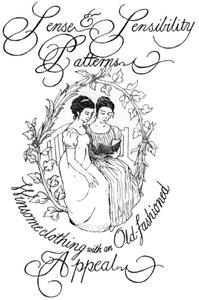1919 Dress from Catalog
This is a picture from a 1919 catalog of a woman in a white dress. Post-WW1, styles drastically changed, a direct reflection of what the world had just ben through. Instead of all the highly structured clothing of even five years before, clothing in the late 19-teens has a looser, more comfortable fit and is often made of "wash" fabrics that can stand more rigorous use. Coco Chanel actually pioneered these relaxed styles beginning in the mid-teens and using soft Jersey knits when wool wasn't available (as it was being used for soldiers' uniforms.)
1918 People's Home Journal Fashion Illustrations
Both of these fashion illustrations come from ads in the same 1918 issue of The People's Home Journal. Although the dresses offered were produced for different companies, they share many of the same features. Note the sheer sleeves as well as the bodice and skirt shapes.
1916 Menswear Catalog
Here is a page from a beautifully illustrated 1916 menswear catalog. The women's clothing in the pictures is lovely, too! This entire catalog is available as a download on my Vintage eBooks page. It's gorgeous with a full-color cover.
1917 Engagement Photo: My Great-Grandparents
These are my great-grandparents, Earl Ethell and Pearl Wright, in 1917 when they were newly engaged. I love his suit and natty bow tie, and her simple dress with its wide, square collar is lovely. They were married more than 50 years.
Alverta Watson Byland Photographs
This photo is labeled "Alverta Watson Byland." This lady is also pictured in the photo below, about ten or fifteen years later. I believe the first photo was taken around 1906.
1917 Day Dress
A cute 1917 day dress from a winter catalogue. Peplums and overskirts were very popular from 1915-1917, creating a more hourglass figure than the columnar styles of 1910-1914. Note the interesting top-curl hairstyle on the model.
1915-1916 Catalog Illustrations
Here is a page from the Weinstock, Lubin & Company's 1915-1916 catalog. These dresses look slightly slimmer than the ones I posted in an earlier post, but you can see the change even from 1913-1914. This entire catalog is available as an eBook in my eBooks section!
1916 Catalog Illustrations
These images all come from the same fantastic 1916 catalog (which I have available as an eBook). I love the color illustrations. I personally think fashions from 1916-1918 look a little "plump" and emphasize areas of the figure I would rather not notice (my hips!), but I still enjoy looking at images from the time period.
Draped 19-Teens Dress Pattern
I love this lady's dress pattern from the mid-to-late-teens. The detailing is so exquisitely feminine, and the fit is flattering without being uncomfortable. Courtesy of the Gullickson Collection
Girls' Dresses from 1916 Catalog
Illustration of young (tween) girls in everyday dresses from a 1916 catalog. These closely mirror adult women's fashions of the time, though the extra frills and shorter skirts give them a younger flair.
1916 Pictorial Review Dress Pattern
This pattern is from Pictorial Review's 1916 line. You can see more examples of this style in the catalog scans that follow in this section (or you can get my 1916-17 catalog eBook). Interesting how fashion went from pencil-thin to full and blouse-y in just three years!
Lace Afternoon Dresses (1915)
Illustration of three girls in fancy lace afternoon dresses from a 1915 catalog. These styles were used a lot for graduation and other special events in a young lady's life.
1915 Woman's Waist Pattern
Woman's waist pattern, circa 1915. Note the long, draped collar and belted waist. Both were popular from about 1914-1918.
1915 Dress Pattern
Woman's dress pattern, circa 1915. Unfortunately, the pattern envelope has torn, making it difficult to see some of the wonderful details of this lovely day dress.
1915 Pattern: May Manton Toddler
This is a darling 1915 pattern for a toddler girl's dress, circa 1915. Note the embroidery and feminine detailing. Many patterns of this era included embroidery transfers that could be traced or iron directly onto fabric so the user could easily follow them to create the motifs.















